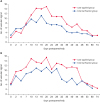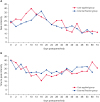1. Baltaxe HA, Shaw DD, Connolly JF. Assessment of healing of long-bone fractures by intraosseous venography. Radiology. 1980; 137:53–56.


2. Barros JW, Barbieri CH, Fernandes CD. Scintigraphic evaluation of tibial shaft fracture healing. Injury. 2000; 31:51–54.


3. Calori GM, Giannoudis PV. Enhancement of fracture healing with the diamond concept: the role of the biological chamber. Injury. 2011; 42:1191–1193.


4. Caruso G, Lagalla R, Derchi L, Iovane A, Sanfilippo A. Monitoring of fracture calluses with color Doppler sonography. J Clin Ultrasound. 2000; 28:20–27.


5. Chang KV, Lew HL, Wang TG, Chen WS. Use of contrast-enhanced ultrasonography in musculoskeletal medicine. Am J Phys Med Rehabil. 2012; 91:449–457.


6. Choi BI, Kim TK, Han JK, Kim AY, Seong CK, Park SJ. Vascularity of hepatocellular carcinoma: assessment with contrast-enhanced second-harmonic versus conventional power Doppler US. Radiology. 2000; 214:381–386.


8. Cruess RL, Dumont J. Fracture healing. Can J Surg. 1975; 18:403–413.

9. de Jong N, Bouakaz A, Frinking P. Harmonic imaging for ultrasound contrast agents. In : Proceedings of IEEE Ultrasonics Symposium; October 22–25, 2000; San Juan, Puerto Rico.
10. den Boer FC, Bramer JA, Patka P, Bakker FC, Barentsen RH, Feilzer AJ, de Lange ES, Haarman HJ. Quantification of fracture healing with three-dimensional computed tomography. Arch Orthop Trauma Surg. 1998; 117:345–350.


11. Duerschmied D, Maletzki P, Freund G, Olschewski M, Seufert J, Bode C, Hehrlein C. Analysis of muscle microcirculation in advanced diabetes mellitus by contrast enhanced ultrasound. Diabetes Res Clin Pract. 2008; 81:88–92.


12. Duerschmied D, Olson L, Olschewski M, Rossknecht A, Freund G, Bode C, Hehrlein C. Contrast ultrasound perfusion imaging of lower extremities in peripheral arterial disease: a novel diagnostic method. Eur Heart J. 2006; 27:310–315.


13. Einhorn TA. The cell and molecular biology of fracture healing. Clin Orthop Relat Res. 1998; 355:S7–S21.

14. Fischer C, Frank M, Kunz P, Tanner M, Weber MA, Moghaddam A, Schmidmaier G, Hug A. Dynamic contrast-enhanced ultrasound (CEUS) after open and minimally invasive locked plating of proximal humerus fractures. Injury. 2016; 47:1725–1731.


15. Frost HM. The biology of fracture healing. An overview for clinicians. Part II. Clin Orthop Relat Res. 1989; (248):294–309.
16. Johnson AL, Houlton JE, Vannini R. AO Principles of Fracture Management in The Dog and Cat. Clavadelerstrasse, Switzerland: Georg Thieme Verlag;2005.
17. Keramaris NC, Calori GM, Nikolaou VS, Schemitsch EH, Giannoudis PV. Fracture vascularity and bone healing: a systematic review of the role of VEGF. Injury. 2008; 39 Suppl 2:S45–S57.

18. Klauser AS, Peetrons P. Developments in musculoskeletal ultrasound and clinical applications. Skeletal Radiol. 2010; 39:1061–1071.


20. Nyman HT, Kristensen AT, Kjelgaard-Hansen M, McEvoy FJ. Contrast-enhanced ultrasonography in normal canine liver. Evaluation of imaging and safety parameters. Vet Radiol Ultrasound. 2005; 46:243–250.


21. Prantl L, Pfeifer C, Geis S, Gosau M, Jung EM. Osteocutaneous free flaps: a critical analysis of quantitative evaluation of bone microcirculation with contrast-enhanced high resolution ultrasound (hrCEUS) and TIC analysis. Clin Hemorheol Microcirc. 2011; 49:251–259.


22. Prantl L, Pfister K, Kubale R, Schmitt S, Stockhammer V, Jung W, Zorger N, Herold T, Nerlich M, Stehr A, Jung EM. Value of high resolution ultrasound and contrast enhanced US pulse inversion imaging for the evaluation of the vascular integrity of free-flap grafts. Clin Hemorheol Microcirc. 2007; 36:203–216.

23. Rawool NM, Goldberg BB, Forsberg F, Winder AA, Hume E. Power Doppler assessment of vascular changes during fracture treatment with low-intensity ultrasound. J Ultrasound Med. 2003; 22:145–153.


24. Risselada M, Kramer M, van Bree H. Approaches for ultrasonographic evaluation of long bones in the dog. Vet Radiol Ultrasound. 2003; 44:214–220.


25. Risselada M, Kramer M, Saunders JH, Verleyen P, Van Bree H. Power Doppler assessment of the neovascularization during uncomplicated fracture healing of long bones in dogs and cats. Vet Radiol Ultrasound. 2006; 47:301–306.


26. Risselada M, van Bree H, Kramer M, Chiers K, Duchateau L, Verleyen P, Saunders JH. Evaluation of nonunion fractures in dogs by use of B-mode ultrasonography, power Doppler ultrasonography, radiography, and histologic examination. Am J Vet Res. 2006; 67:1354–1361.


27. Schoierer O, Bloess K, Bender D, Burkholder I, Kauczor HU, Schmidmaier G, Weber MA. Dynamic contrast-enhanced magnetic resonance imaging can assess vascularity within fracture non-unions and predicts good outcome. Eur Radiol. 2014; 24:449–459.


28. Shapiro RS, Wagreich J, Parsons RB, Stancato-Pasik A, Yeh HC, Lao R. Tissue harmonic imaging sonography: evaluation of image quality compared with conventional sonography. AJR Am J Roentgenol. 1998; 171:1203–1206.
















 PDF
PDF Citation
Citation Print
Print



 XML Download
XML Download